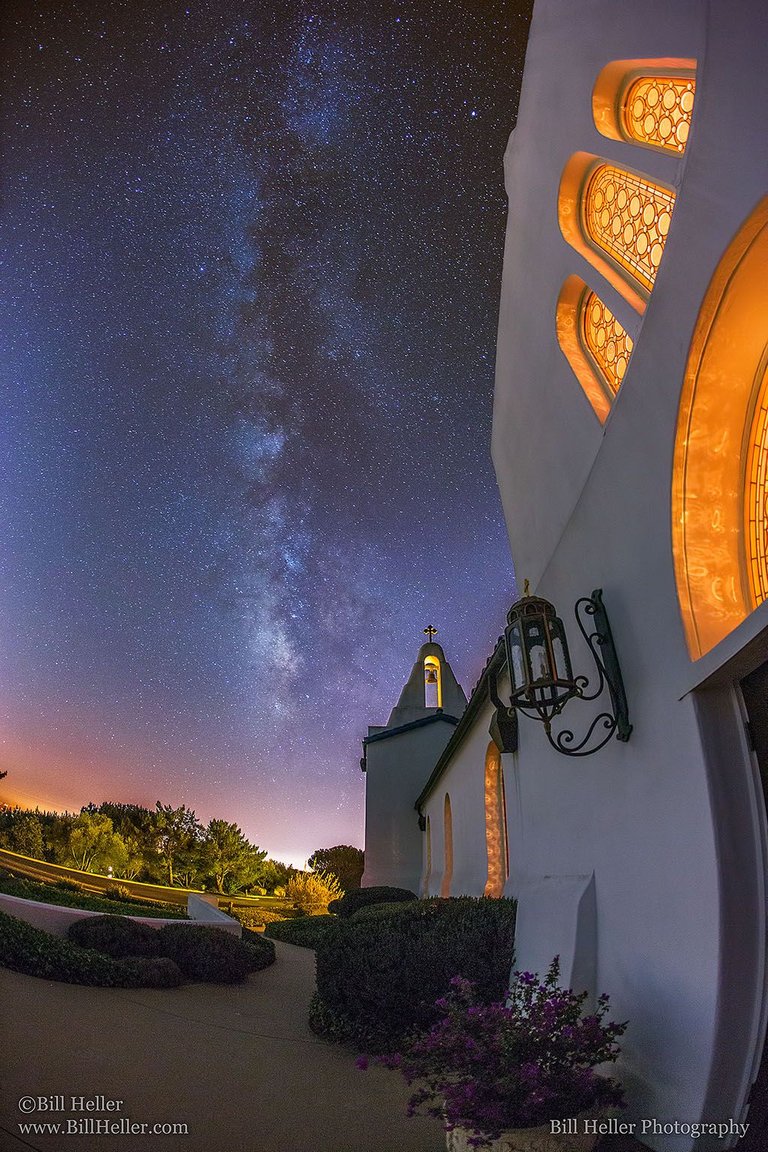The Milky Way
Every evening as we go about our lives there is an amazing ballet going on above our heads. Most of us are too busy to think about it. But if you take some time to get away from the brighter lights of the city you can see some spectacular things just by looking up. In the middle of this shot is the Milky Way Galaxy, the galaxy we call home. If you think of all those stars at night that you usually see from any location, they are in general just our local neighbors in a small part of the Milky Way. All the visible stars you can make out as points of light with your naked eye in every direction from the earth (anywhere between five to ten thousand stars give or take) only comprise a tiny fraction of the stars in the Milky Way. That glowing band however, is made up of individual stars so numerous that they appear to be a continuous cloud of light to the unaided eye. Estimates put it from one to four hundred billion stars.

Heaven and Earth - The Santa Barbara Greek Orthodox Church and the Milky Way Galaxy shot in the mountains above Santa Barbara.
Astrophotography
I love astrophotography, but not just photographing the beauty of the night sky by itself. The Milky Way makes the most amazing backdrop for just about anything. Of course, the motion of the earth makes any kind of astrophotography a challenge. Even with today's amazing digital cameras and a wide angle lens you only get 30 seconds at most to get an image before the stars no longer look like points of light. (Much less with a telephoto lens or telescope.) When photographing the sky alone this can easily be compensated for by stacking multiple exposures and with mounts that track the movement of the earth. Imagine a tripod mount, with something like a clock on it that makes one revolution every 24 hours. If you line that up correctly, it negates the motion of the earth and you can take very long exposures to see the most amazing things.
Foreground Objects
The difficulty comes when you want to add foreground objects into the scene. This is where things get much more challenging and creative. Not only do you have to find objects that are dimly lit enough to allow the faint light of the stars to reach your sensor (or film), but you need to be able to frame the composition, while avoiding streetlights, passing car headlights and a myriad of other little surprises. All while in some cases only being able to faintly see one of your main subjects. Most of the newer tripod mounts can help with foreground compositions though. By moving at half speed, they effectively double your exposure time before either the sky or the foreground starts to blur. But as with anything worth doing, there is still a fair amount of skill and practice required to get the shot. Of course, that only makes it that much more satisfying once you do.
More?
If you are interested in the techniques and tools I use feel free to ask in the replies. If there is interest I would be happy to do some more technical how-to's.
Excellent photo, please provide some info on your equipment and exposure data, so that others can learn. Upvoted, resteemed & Daily Photo Selection.
Hey, thanks @photo-trail. This was actually a fairly simple shot with a Canon 5D Mark II, and a Canon 15mm Fisheye lens at f4. The lens goes down to f2.8 but I find I get a little sharper shot at f4 and it's worth the loss of light. The trade off is I needed ISO 4000, which the 5D can handle pretty well. It's always good to do some tests with your lens to find those trade offs. Since the lens is so wide I was able to do a 35 second exposure with a cable release locked down on a really solid tripod (even the wind is a problem trying to get good sharp points of light.) The sky was masked and color corrected to allow more detail and contrast in the Milky Way. Out of the camera, the night sky has a reddish brown color from scattered light, and filtering that out gives a more pleasing color and allows more contrast and detail in the sky.
The hard part of the photo as I eluded to in the description was the street lights and passing cars on the street to the left. I had to find just the right spot where the streetlights were blocked well by the trees. Even though they are out of the frame to the left, the glare would be terrible at these settings if they weren't well hidden.
Oh and all of the artificial lights both in the church and on the trees in the distance are very small security lights. Believe it or not... the main lights of the church were off. Think about how dim the sky is, if the lights in the church were all on the windows would just be blown out white. The lighting and everything in the scene was all very subtle, it took several minutes for my eyes to adjust after driving there to even begin to frame the composition.
Excellent post! Thanks for photo and for additional information!
And both funny and humbling to think how little earth is in comparison to the whole cosmos.Wow you really got some great skill @bhp :)